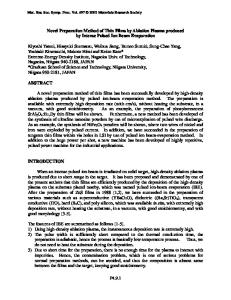Preparation of SrFeO3-X Thin Films by the Spin-Coating Method and its Gas Sensing Properties
- PDF / 95,239 Bytes
- 6 Pages / 612 x 792 pts (letter) Page_size
- 55 Downloads / 401 Views
0972-AA12-05
Preparation of SrFeO3-X Thin Films by the Spin-Coating Method and its Gas Sensing Properties Abdul Majid1, Egmont Gollner2, Mahesh Matam3, Jim Tunney1, and Mike Post1 1 Institute for Chemical Process and Environmental Technology, National Research Council of Canada, Ottawa, K1A0R6, Canada 2 University of Bayreuth, Bayreuth, D-95440, Germany 3 Omega Piezo Technologies, Inc., State College, PA, 16801
ABSTRACT Nanostructured coatings have recently attracted increasing interest because of the possibilities of synthesizing materials with unique physical-chemical properties. In this report we describe our efforts at developing a methodology for the fabrication of SrFeO3-X based thin films using a modified Pechini method. Thin films of SrFeO3-X were fabricated using a spin coating and PLD method on Al2O3. The films annealed at 600 oC for one hour show a perovskite phase. The sensors based on SrFeO3-X thin films on alumina were fabricated using spin coating and PLD techniques. The sensing properties were determined using propane and propene as the probing gases. Response characteristics and temperature dependency of spin coated and PLD fabricated samples were compared. The effect of the electrode material, Au and/or Pt, on the gas detection sensitivity of the SrFeO3-X thin films was also investigated. INTRODUCTION The discovery that the adsorption of gas on the semiconductor surface causes a significant change in the electrical resistance of the material [1] initiated the development of commercial gas sensors based on semiconductors whose surface properties are very sensitive to changes in the gas atmosphere. Gas sensors based on thick-film semi-conducting metal oxide materials deposited on ceramic heater substrates are commercially available [2-4]. However, compared with thick films, the thin films have been shown to have the potential to improve upon sensor sensitivity and selectivity [5-7]. SrFeOx [8-11] and other perovskites based on the SrFeyCo1-yOx (0 ≤ y ≤ 1.0; 2.5 ≤ x ≤ 3.0) system [12,13] are mixed ionic electronic conductors in which the reversible oxygen nonstoichiometry may be exploited for gas sensor applications. These materials undergo reversible phase transitions from the conductive cubic perovskite structure to the much less conductive brownmillerite structure. The phase transitions are very sensitive to temperature and gas composition [12, 13], thus providing the basis for a highly sensitive sensor material. It is important to tailor the micro and nano structure of metal oxide gas sensor materials in order to fully optimize their sensitivity, selectivity and response speed [14-17].
Our previous investigations [10-13] on the sensor applications of perovskite materials involved fabrication of thin films of these materials by pulsed laser deposition (PLD) method using materials synthesized by the solid-state reaction at high temperatures of the corresponding binary metal oxides or carbonates. Compared to more traditional coating methods, e.g., PLD, CVD, sputtering and evaporation, the solutio
Data Loading...











